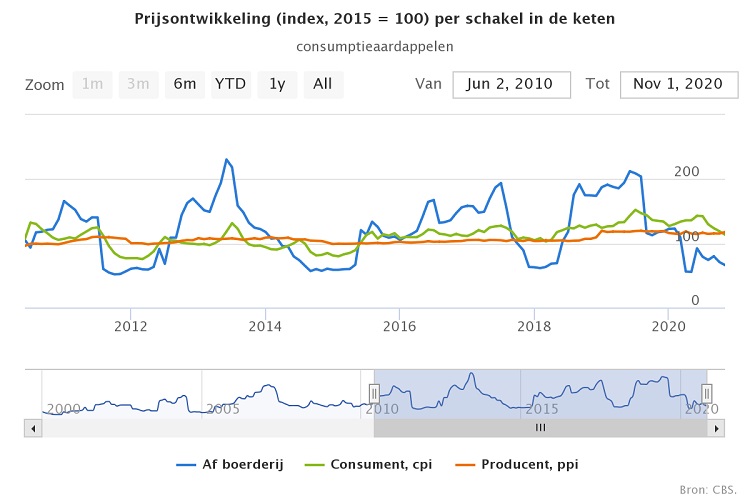The producer price index fell from early 2020 but recovered to 118 points in November in recent months, 2% higher than two months earlier.Due to the corona crisis, the potato price at farm fell very sharply in April and May of 2020, then recovered in September, then fell back to a very low level of 66 points in November, 17% lower than in September this year and 44% lower than in November 2019.

Potato price ex farm
The potato price ex farm was considerably lower in the 2019/2020 season than in the previous, very dry season 2018/2019. In September 2019 the index was 116 points. In combination with the continued good demand, potato prices rose to 123 points in February 2020. However, from March to May, the price fell to a low of 56 points as a result of the corona crisis. Around 1 March 2020, the warehouses still had a stock of more than 1 million tons of potatoes. Grower prices will recover somewhat from May and will be 80 points in September 2020. Due to the second lockdown, the sales of potato products stagnated again in many countries, causing grower prices to fall to 66 points in November, 17% lower than in September and 44% lower than a year earlier.
Chain
Table potatoes, chilled and frozen potato products are for sale in specialty stores and the supermarket. Table potatoes are purchased from growers by the potato cooperative or private trade, sorted and packaged and delivered to supermarkets and shops via distribution centers. Sometimes growers or traders also deliver directly to shops. The lion’s share of Dutch consumption potatoes is processed into French fries, crisps and chilled products. The potato processing industry processes more than 4 million tons of potatoes every year and buys most of the required potatoes directly from the grower, often on contract. In addition to supermarkets, potato products are sold in (fast food) restaurants and snack bars.

Explanation on three levels
Dutch consumers buy approximately 375,000 tons of table potatoes annually, approximately 80% via the supermarket. For chilled products, the share at supermarkets is 95%. The number of companies processing (sorting, washing, packaging) fresh potatoes for the table potato market is decreasing and is close to 80 (NAO, 2015). The 5 to 8 larger packaging companies control an important part of the domestic trade; they supply the Dutch supermarkets for 80 to 90%, whether or not via a service provider.
A small part of the domestic table potato demand consists of imports, which mainly take place in early spring when domestic stocks run out or deteriorate. These imported early table potatoes come from southern Member States such as Spain, Portugal, Italy and Malta. Most of the packaging companies export potatoes, often via an exporter. These exports amount to 400,000 tons, half of which has a destination outside the EU.

Within the processing industry (non-table potatoes) there are four larger companies that process 85% of the volume. They operate globally and have several production locations in the Netherlands and abroad. Of the 4 million tons of potatoes processed by the industry, two thirds come from Dutch soil and one third is imported. About 85% of the potato products are exported frozen, about 80% within Europe and 20% to third countries (Association for the Potato Processing Industry, VAVI). The continuous growth of exports to Asia, among others, means that companies are expanding their capacity.
The number of arable farms that grow ware potatoes varies between 6,500 and 7,000. Partly because of the necessary crop rotation, the potato growers also grow other crops. They produce an average of 3.9 million tons of ware potatoes annually. Ware potatoes are planted in the spring and harvested in the period August-October. Potatoes are delivered immediately after harvest or stored on the farm in storage areas and delivered on demand. Depending on the variety and quality, potatoes can be stored until June-July, but storage leads to weight and sometimes loss of quality.
Pricing
The consumer price follows the price development in the potato market, but the relative results are smaller than for ex-farm prices. This is partly because the consumer price is composed of both fresh potatoes (table potatoes) and processed potatoes. In order to secure an important part of their raw material supply, processors and traders offer contracts prior to the growing season. About 75-80% of the potatoes that the processing industry processes are pre-contracted. There is a wide variety of contract types. Because processors purchase potatoes on a contract, they can maintain relatively stable sales prices. Producer prices are therefore considerably less volatile than ex-farm prices.
The margins of the packaging and export companies have been under pressure in years with high potato prices; in years with low prices, the Netherlands is better able to cope with competition on foreign markets. Potato growers sell their product on a contract basis or via the open market. On the free market, prices are determined by supply and demand in the main potato countries in northwestern Europe: the Netherlands, France, Germany, Belgium, the United Kingdom and Poland.


